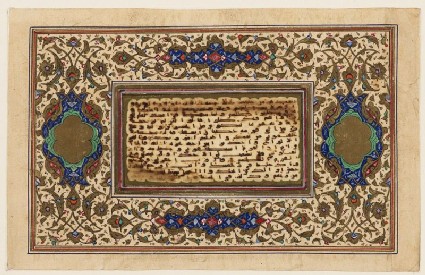Search Results: objects
Show search help- Reference URL
Actions
Page from a miniature Qur’an in kufic script
-
Description
Ali, the cousin and son-in-law of the Prophet Muhammad and a master of kufic script according to tradition, exhorted to copy the Qur’an in large letters so that the majesty and dignity of God’s word could be aptly conveyed. Yet, the fragment at the centre of this elaborate page (Qur’an, 23:94) demonstrates how small-scale copies of the text were also produced very early on.
Miniature Qur’ans were essentially used as amulets, and carried in boxes or worn. The illuminated margins were added at a later time, to preserve and bring value to the fragment.
-
Details
- Associated place
- Date
-
calligraphy 9th century AD (AD 801 - 900)
painting possibly 18th - 19th century (1701 - 1900)
- Material and technique
- calligraphy with ink, colour, and gold on parchment; mounted on paper, with ink, colour, and gold
- Dimensions
-
mount 39.5 x 28 cm (height x width)
page 10.5 x 16 cm (height x width)
painting 9 x 14.5 cm approx. (height x width)
calligraphy 3.3 x 6.7 cm approx. (height x width)
- Material index
- Technique index
- Object type index
- No. of items
- 1
- Credit line
- Presented by Dr John Pincent, in memory of Haim Nahmad, 1993.
- Accession no.
- EA1993.16
Glossary
kufic
-
kufic
A term denoting various styles of angular Arabic script. Emerged in the early centuries of Islam, kufic soon became the preferred hand to copy holy texts.
Past Exhibition
see (1)Location
-
- currently in research collection
Objects are sometimes moved to a different location. Our object location data is usually updated on a monthly basis. Contact the Jameel Study Centre if you are planning to visit the museum to see a particular object on display, or would like to arrange an appointment to see an object in our reserve collections.
© 2013 University of Oxford - Ashmolean Museum


